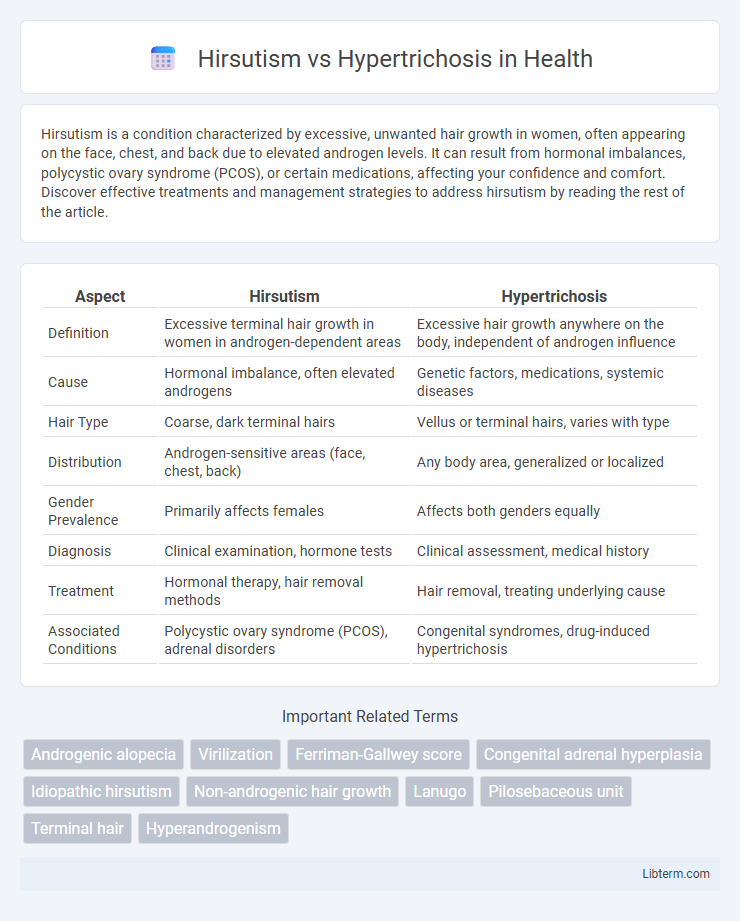Hirsutism is a condition characterized by excessive, unwanted hair growth in women, often appearing on the face, chest, and back due to elevated androgen levels. It can result from hormonal imbalances, polycystic ovary syndrome (PCOS), or certain medications, affecting your confidence and comfort. Discover effective treatments and management strategies to address hirsutism by reading the rest of the article.
Table of Comparison
| Aspect | Hirsutism | Hypertrichosis |
|---|---|---|
| Definition | Excessive terminal hair growth in women in androgen-dependent areas | Excessive hair growth anywhere on the body, independent of androgen influence |
| Cause | Hormonal imbalance, often elevated androgens | Genetic factors, medications, systemic diseases |
| Hair Type | Coarse, dark terminal hairs | Vellus or terminal hairs, varies with type |
| Distribution | Androgen-sensitive areas (face, chest, back) | Any body area, generalized or localized |
| Gender Prevalence | Primarily affects females | Affects both genders equally |
| Diagnosis | Clinical examination, hormone tests | Clinical assessment, medical history |
| Treatment | Hormonal therapy, hair removal methods | Hair removal, treating underlying cause |
| Associated Conditions | Polycystic ovary syndrome (PCOS), adrenal disorders | Congenital syndromes, drug-induced hypertrichosis |
Introduction to Hirsutism and Hypertrichosis
Hirsutism is characterized by excessive, male-pattern hair growth in women, primarily influenced by androgen levels, often linked to hormonal disorders like polycystic ovary syndrome (PCOS). Hypertrichosis involves abnormal hair growth over the entire body or in localized areas, affecting both genders and unrelated to androgen excess. Differentiating between hirsutism and hypertrichosis is crucial for accurate diagnosis and tailored treatment strategies.
Definition of Hirsutism
Hirsutism is characterized by excessive, male-pattern hair growth in women, typically on the face, chest, and back, caused by elevated androgen levels or increased sensitivity of hair follicles to androgens. It differs from hypertrichosis, which involves generalized, abnormal hair growth in areas not influenced by androgens and can affect both genders. Understanding hirsutism is crucial for diagnosing underlying endocrine disorders such as polycystic ovary syndrome (PCOS) or adrenal hyperplasia.
Definition of Hypertrichosis
Hypertrichosis is characterized by excessive hair growth over and above the normal for a person's age, sex, and race, affecting large areas or the entire body. This condition can be congenital or acquired and differs from hirsutism, which specifically refers to excessive terminal hair in women in androgen-dependent areas like the face and chest. Hypertrichosis involves abnormal hair growth unrelated to androgen levels, making it a distinct clinical diagnosis from hormonal-related hirsutism.
Key Differences Between Hirsutism and Hypertrichosis
Hirsutism is characterized by excessive, male-pattern hair growth in women, often caused by elevated androgen levels or hormonal imbalances, primarily affecting areas like the face, chest, and back. Hypertrichosis involves abnormal hair growth on any part of the body regardless of sex or age and is not typically related to hormonal factors but may result from genetic disorders, medications, or systemic conditions. The key difference lies in hirsutism's androgen-dependent, sex-specific pattern versus hypertrichosis's generalized, non-androgen-dependent excessive hair growth.
Causes of Hirsutism
Hirsutism is primarily caused by elevated androgen levels or increased sensitivity of hair follicles to androgens, often linked to conditions such as polycystic ovary syndrome (PCOS), adrenal hyperplasia, or androgen-secreting tumors. Unlike hypertrichosis, which involves excessive hair growth regardless of androgen levels, hirsutism specifically manifests as male-pattern hair growth in women due to hormonal imbalances. Understanding the endocrine origins of hirsutism is critical for accurate diagnosis and targeted treatment.
Causes of Hypertrichosis
Hypertrichosis is characterized by excessive hair growth independent of androgen levels, often caused by genetic mutations, certain medications like minoxidil or phenytoin, and metabolic disorders including porphyria. Unlike hirsutism, which results from androgen excess affecting hair growth in a male-pattern distribution, hypertrichosis can occur diffusely across the body and affect both men and women equally. Congenital forms of hypertrichosis may be inherited, while acquired forms are frequently linked to systemic diseases, malignancies, or drug-induced effects.
Symptoms and Clinical Presentation
Hirsutism presents as excessive, male-pattern hair growth in women, typically on the face, chest, and back, driven by androgen excess and often linked to conditions like polycystic ovary syndrome or adrenal disorders. Hypertrichosis involves generalized or localized excessive hair growth that is not androgen-dependent, affecting both genders and can present from birth (congenital) or develop later (acquired) due to medications or systemic diseases. Clinical examination distinguishes hirsutism by coarse, terminal hair in androgen-sensitive areas, while hypertrichosis shows thicker or vellus hair proliferation beyond typical patterns without hormonal imbalance.
Diagnosis and Differentiation
Hirsutism is characterized by excessive terminal hair growth in androgen-dependent areas, primarily affecting women and often linked to hormonal imbalances like polycystic ovary syndrome (PCOS), whereas hypertrichosis involves generalized excessive hair growth unrelated to androgen sensitivity. Diagnosis of hirsutism relies on clinical evaluation and scoring systems such as the Ferriman-Gallwey score, supplemented by hormonal assays to assess androgen levels. Differentiation from hypertrichosis requires distinguishing hair distribution patterns and underlying causes, with hypertrichosis often presenting as congenital or drug-induced and involving vellus or terminal hair beyond androgen target sites.
Treatment Options for Each Condition
Hirsutism treatment primarily involves addressing underlying hormonal imbalances through anti-androgens, oral contraceptives, or insulin-sensitizing agents, combined with cosmetic methods like laser hair removal and electrolysis for long-term hair reduction. Hypertrichosis management focuses on symptomatic hair removal techniques including shaving, waxing, depilatory creams, and laser therapy, while identifying and treating potential causative factors such as medications or systemic diseases. Both conditions benefit from personalized treatment plans guided by endocrinologists or dermatologists to optimize results and minimize side effects.
Living with Excess Hair Growth: Lifestyle and Support
Managing life with excess hair growth due to hirsutism or hypertrichosis involves tailored grooming routines and psychological support to boost self-esteem. Medical treatments like laser therapy or prescription medications, combined with counseling or support groups, enhance overall well-being. Emphasizing skin care and adopting adaptive clothing choices help individuals comfortably navigate daily social and professional environments.
Hirsutism Infographic

 libterm.com
libterm.com